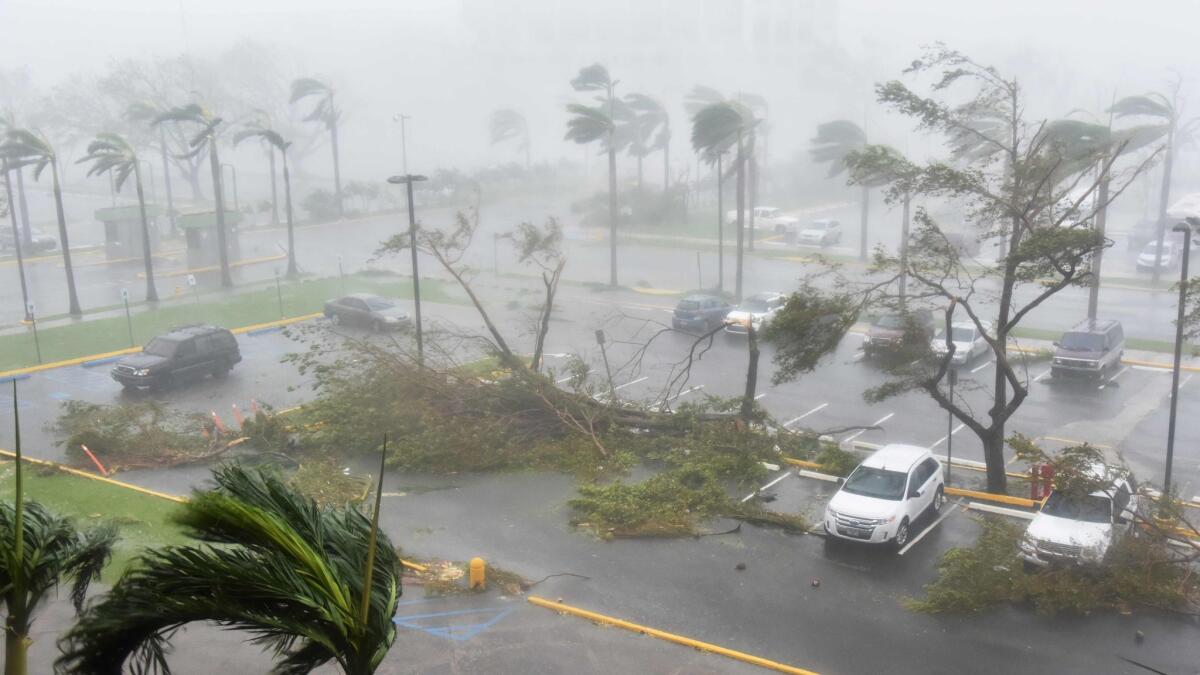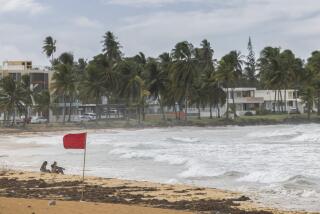Hurricane Maria stripped Puerto Rico’s forests bare. Now conservationists and scientists are working to replenish them
When Hurricane Maria tore through Puerto Rico last September, the physical destruction was not limited to houses, buildings, the electricity grid and other infrastructure. The storm also toppled or stripped bare an estimated 480 million trees, or a third of all the forests.
Green buds, ferns and grasses have started to sprout in the understory of the forests, though it is expected to take much longer for higher elevations to regain their lushness.
For the record:
11:40 a.m. March 1, 2018A previous version of this article said that Puerto Rico currently has legal protections in place for 8% of its area. The correct figure is 16%, The article also said that work is underway to restore 400-plus native tree and plant species. This figure refers only to tree species.
“In some areas at the top of the mountains it might take more than 50 or 100 years” to recover, said Grizelle Gonzalez, a scientist at the International Institute of Tropical Forestry, a program of the U.S. Forest Service.
To give Mother Nature a hand, various reforestation efforts are underway across the U.S. territory.
Through Para la Naturaleza, an initiative of the Conservation Trust of Puerto Rico, work is ongoing to analyze the damage and restore 400-plus native tree species.
Trees will be replanted in the organization’s nurseries, in many cases using fallen foliage as compost and downed branches and wood chips as mulch.
Armed with bags and notepads, volunteers will fan out across forests, picking through the undergrowth in search of seeds to be replanted, said Fernando Lloveras San Miguel, executive director of the Conservation Trust.
“The tough part is going to be trying to walk through different forested areas, because there’s a lot of dead trees … and it’s going to be very hard to access these places,” he said.
Communities near the island’s nature reserves are being encouraged to participate in the efforts, with the aim of preserving 33% of Puerto Rico’s land for nature by 2033, said Lloveras San Miguel. The island currently has legal protections in place for 16% of its area.
“We believe ecology recovery goes hand in hand with human recovery,” Lloveras San Miguel said. “That’s the biggest importance of this effort. We don’t think any Puerto Rican can recover fully without having [the] surroundings, nature, the landscape fully recovered. Each one has to support the other. So that’s why the engagement of the community in the reforestation will really bring on a symbiotic relationship with their own recovery process.”
Still, humans are going to be secondary players in helping nature rebound.
“The greatest re-foresters are bats and birds,” Lloveras San Miguel said. “They are the key farmers on Earth. They are going to be doing most of the work.”
But only once these wildlife species recover themselves.
Scientists are still gathering the data, but avian life is believed to have taken a major hit, said Gonzalez, the forestry service scientist.
Birds started dying after the hurricane because seed, berries and other food sources were diminished, Gonzalez said. Other species, including insects and lizards, lost shelter and places to feed and hide.

Some wildlife has started migrating toward the coast and lower elevations where the vegetation is recovering much faster, Gonzalez said. Iguanas and other reptiles prefer a forested environment but can easily adjust to uncovered open spaces. But conservationists are concerned about the possibility of runaway population growth — and the ecological imbalances that could result.
One area of particular concern to conservationists is El Yunque National Forest, a tropical rainforest that is the island’s second-most visited tourist attraction and a key source of water for nearby communities.
“Immediately after the hurricane it looked like a dry landscape,” Gonzalez said. “Instead of green, it was brown. During a dry spell it was very crunchy. But now the greens are heavier. You see that the vegetation is recovering.”
The revival is due in part to the “ecological memory” of forests, she said.
If there is any good news from the hurricane, it is that the stripping of the forests to their bare bones has given scientists a rare chance to study nature.
“We need to take advantage of the opportunity to document the impact on the environment and the ecosystem, and the services the environment provides to the people,” Gonzalez said.
For more on global development news, see our Global Development Watch page, and follow me @AMSimmons1 on Twitter.
More to Read
Sign up for Essential California
The most important California stories and recommendations in your inbox every morning.
You may occasionally receive promotional content from the Los Angeles Times.









